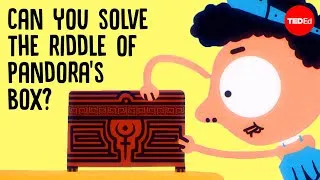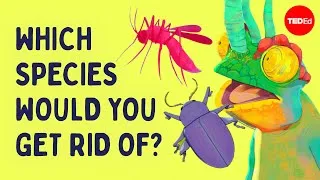請雙擊下方英文字幕播放視頻。
譯者: Marssi Draw
審譯者: Amanda Chu
00:06
In the 16th century, Flemish physician
Andreas Vesalius
0
6778
4100
十六世紀時,一位在法蘭德斯
名叫安德雷亞斯·維薩里的醫生
00:10
described how a suffocating animal
could be kept alive
1
10878
3750
描述過一種讓窒息動物不死的方式,
00:14
by inserting a tube into its trachea
and blowing air to inflate its lungs.
2
14628
6741
是透過將管子插進牠的氣管,
然後灌入空氣讓牠的肺部膨脹。
00:21
In 1555, this procedure didn’t warrant
much acclaim.
3
21369
4173
在 1555 年時,
這個醫療手段沒得到太多讚賞。
00:25
But today, Vesalius’s treatise
is recognized
4
25542
3360
但如今維薩里的論文
被視為呼吸器的第一份記載,
00:28
as the first description
of mechanical ventilation—
5
28902
3870
00:32
a crucial practice in modern medicine.
6
32772
3400
而呼吸器是現代醫學的重要醫療方式。
00:36
To appreciate the value of ventilation,
7
36172
2970
要懂得呼吸器的價值,
00:39
we need to understand how
the respiratory system works.
8
39142
3870
我們必須先了解呼吸系統怎麼運作。
00:43
We breathe by contracting our diaphragms,
which expands our chest cavities.
9
43012
5759
我們透過收縮橫膈膜來呼吸,
橫膈膜會擴張我們的胸腔。
00:48
This allows air to be drawn in,
inflating the alveoli—
10
48771
5317
這樣能讓空氣吸進來,讓肺泡充氣,
00:54
millions of small sacs inside our lungs.
11
54088
4297
肺泡是肺裡的上百萬顆小泡囊。
00:58
Each of these tiny balloons is surrounded
by a mesh of blood-filled capillaries.
12
58385
5873
每個小氣球四周
都被充滿血液的微血管網包圍。
01:04
This blood absorbs oxygen
from the inflated alveoli
13
64258
4817
血液從膨脹的肺泡吸進氧氣,
01:09
and leaves behind carbon dioxide.
14
69075
3470
留下二氧化碳。
01:12
When the diaphragm is relaxed,
15
72545
1980
一旦橫隔膜放鬆,
01:14
the CO2 is exhaled alongside
a mix of oxygen and other gases.
16
74525
6161
二氧化碳就會隨著
氧氣和其它氣體被吸入。
01:20
When our respiratory systems
are working correctly,
17
80686
3170
我們的呼吸系統運作正常的話,
01:23
this process happens automatically.
18
83856
2710
這個過程就會自動發生。
01:26
But the respiratory system can be
interrupted by a variety of conditions.
19
86566
4780
但是呼吸系統也可能
因為各種情況受阻。
01:31
Sleep apnea stops diaphragm muscles
from contracting.
20
91346
4681
睡眠呼吸中止症
會讓橫隔膜的肌肉無法收縮。
01:36
Asthma can lead to inflamed airways
which obstruct oxygen.
21
96027
4649
氣喘可能會造成氣道發炎,
進而阻隔氧氣。
01:40
And pneumonia, often triggered
by bacterial or viral infections,
22
100676
5113
通常因細菌或病毒感染而引起的肺炎
01:45
attacks the alveoli themselves.
23
105789
2860
會攻擊肺泡。
01:48
Invading pathogens kill lung cells,
24
108649
2980
病原體侵入殺死肺細胞,
01:51
triggering an immune response
that can cause lethal inflammation
25
111629
4515
引起的免疫反應可能造成嚴重發炎
01:56
and fluid buildup.
26
116144
1930
和肺部積水。
01:58
All these situations render the lungs
unable to function normally.
27
118074
5214
這些情況都讓肺無法正常運作。
02:03
But mechanical ventilators
take over the process,
28
123288
3880
但呼吸器接管這個程序,
02:07
getting oxygen into the body
when the respiratory system cannot.
29
127168
4787
在呼吸系統失靈的時候,
將氧氣帶入身體。
02:11
These machines can bypass
constricted airways,
30
131955
3430
這些機器可以繞過受阻的氣道,
02:15
and deliver highly oxygenated air
to help damaged lungs diffuse more oxygen.
31
135385
6700
傳送含氧量高的空氣,
協助散布更多氧氣到受損的肺中。
02:22
There are two main ways
ventilators can work—
32
142085
3200
呼吸器主要有兩種運作方式:
02:25
pumping air into the patient’s lungs
through positive pressure ventilation,
33
145285
4881
用正壓呼吸器把空氣打進病人肺部,
02:30
or allowing air to be passively drawn
in through negative pressure ventilation.
34
150166
5786
或用負壓呼吸器讓空氣被動吸入。
02:35
In the late 19th century,
35
155952
1850
在 19 世紀末,
02:37
ventilation techniques largely
focused on negative pressure,
36
157802
4000
呼吸器技術大部分都著重在負壓,
02:41
which closely approximates
natural breathing
37
161802
2650
因為這個方式較像自然呼吸,
02:44
and provides an even distribution
of air in the lungs.
38
164452
4439
也讓空氣在肺部能分布得較為平均。
02:48
To achieve this, doctors created
a tight seal around the patient’s body,
39
168891
5305
為了做到負壓,醫生
會用裝置密封病人身體,
02:54
either by enclosing them in
a wooden box or a specially sealed room.
40
174196
6367
可能是把病人放在
木盒或特製的密封室。
03:00
Air was then pumped
out of the chamber,
41
180563
2624
然後將空氣抽出,
03:03
decreasing air pressure,
and allowing the patient’s chest cavity
42
183187
3840
減少氣壓,讓病人的胸腔
03:07
to expand more easily.
43
187027
2580
能更輕易的擴張。
03:09
In 1928, doctors developed
a portable, metal device
44
189607
5095
1928 年,醫生製造了
可攜式金屬裝置,
03:14
with pumps powered
by an electric motor.
45
194702
3666
裡面有用電動馬達驅動的幫浦。
03:18
This machine, known as the iron lung,
46
198368
2990
這個機器也就是俗稱的鐵肺,
03:21
became a fixture in hospitals
through the mid-20th century.
47
201358
4788
在 20 世紀中成為醫院的固定裝置。
03:26
However, even the most compact
negative pressure designs
48
206146
4020
然而,即使最完善的負壓設計,
03:30
heavily restricted a patient’s movement
49
210166
2380
都大大限制病人的行動,
03:32
and obstructed access for caregivers.
50
212546
3790
也妨礙醫護人員服務。
03:36
This led hospitals in the 1960’s to shift
towards positive pressure ventilation.
51
216336
6001
這讓 1960 年代的醫院
轉而使用正壓呼吸器。
03:42
For milder cases,
this can be done non-invasively.
52
222337
4000
對病情較輕的患者而言,
不需侵入他們的身體就能做到。
03:46
Often, a facemask is fitted
over the mouth and nose,
53
226337
3390
一般會有面罩蓋住口鼻,
03:49
and filled with pressurized air
which moves into the patient’s airway.
54
229727
5145
加壓的空氣會送進病人的氣道。
03:54
But more severe circumstances
55
234872
2100
但較嚴重的病人
03:56
require a device that takes over
the entire breathing process.
56
236972
4837
需要能完全代替病人呼吸的儀器。
04:01
A tube is inserted
into the patient’s trachea
57
241809
3420
插入病人氣管的管子
04:05
to pump air directly into the lungs,
58
245229
2730
會把空氣直接打進他的肺部,
04:07
with a series of valves
and branching pipes
59
247959
3090
一連串的氣閥和支管
04:11
forming a circuit for inhalation
and exhalation.
60
251049
4000
形成吸氣和呼氣的迴路。
04:15
In most modern ventilators,
61
255049
1830
大部分新型呼吸器會內建電腦系統,
04:16
an embedded computer system
62
256879
2050
04:18
allows for monitoring the patient’s
breathing and adjusting the airflow.
63
258929
4507
能夠監控病人呼吸、調整氣流。
04:23
These machines aren’t used
as a standard treatment,
64
263436
3784
這些機器不是用在一般標準治療上,
04:27
but rather, as a last resort.
65
267220
2580
而是不得已時的最後手段。
04:29
Enduring this influx of pressurized air
requires heavy sedation,
66
269800
5245
要病人忍受這種加壓空氣,
需要施以高劑量鎮靜藥物,
04:35
and repeated ventilation
can cause long-term lung damage.
67
275045
4217
而且重覆換氣可能
造成肺部長期損傷。
04:39
But in extreme situations,
68
279262
2406
但是在危急的情況下,
04:41
ventilators can be the difference
between life and death.
69
281668
3603
呼吸器能攸關生死。
04:45
And events like the COVID-19 pandemic
70
285271
2790
像新型冠狀病毒肺炎大流行的情況,
04:48
have shown that they’re even more
essential than we thought.
71
288061
3980
可以看到呼吸器
比我們想像中還要不可或缺。
04:52
Because current models
are bulky, expensive,
72
292041
3060
因為目前的樣式都很笨重、昂貴,
04:55
and require extensive training to operate,
most hospitals only have a few in supply.
73
295101
6802
而且需要大量訓練才能操作,
大部分的醫院只有少數幾臺可用。
05:01
This may be enough
under normal circumstances,
74
301903
3050
也許在一般情況下還夠,
05:04
but during emergencies,
this limited cache is stretched thin.
75
304953
4244
但是在緊急時刻,
這些儲糧僧多粥少。
05:09
The world urgently needs more low-cost
and portable ventilators,
76
309197
5049
世界亟需更多低成本的
可攜式呼吸器,
05:14
as well as a faster means
of producing and distributing
77
314246
4040
以及能夠快速製造、
傳播這種救命技術的方法。
05:18
this life-saving technology.
78
318286
2246
New videos
關於本網站
本網站將向您介紹對學習英語有用的 YouTube 視頻。 您將看到來自世界各地的一流教師教授的英語課程。 雙擊每個視頻頁面上顯示的英文字幕,從那裡播放視頻。 字幕與視頻播放同步滾動。 如果您有任何意見或要求,請使用此聯繫表與我們聯繫。







